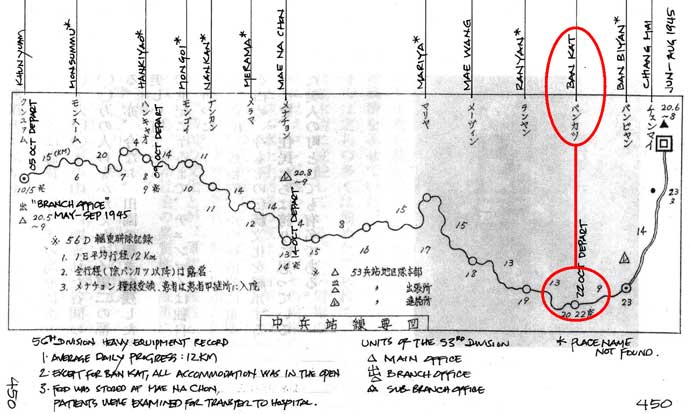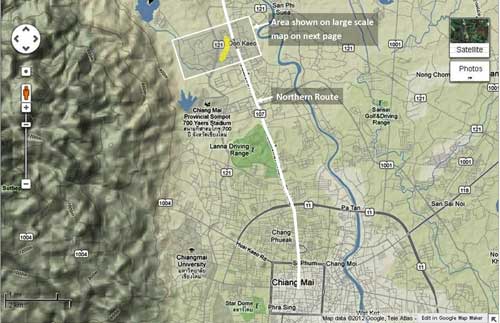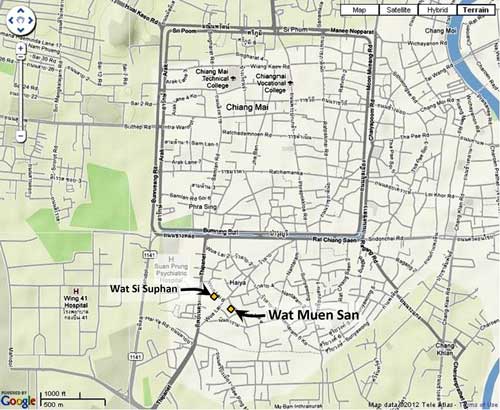APPENDIX
As already noted, the only reference found for this site to date is in 戦没者遺骨収集の記録 ピルマ・インド・タイ [Journal on Collection of War Dead: Burma, India, Thailand] (Tokyo: All Burma Comrades Organization, 1980) 1 That source, however, does quote numerous Japanese language references.
The book contains the following relevant information:
[p 425] . . . The Second Group collecting remains worked with patriotic zeal so that no stone would remain unturned, searching out new information as well as reviewing places that reported completed by the first collection group, which had included Don Kaeo with 268 remains disinterred . . . . [p 446] . . . In a teak forest in Don Kaeo, 4 km northwest of Chiang Mai, the 121st and 124th Military Hospitals operated, with a graveyard about 500 m to the west. Also, outside the village of Mae Taeng was said to have been the 105th Military Hospital. A patient’s journal recalled:Not very far from Chiang Mai was a rather large village called ___ [left blank in reference]. We made it to the hospital there in the evening. There are three hospitals [in the area], at Chiang Mai, Don Kaeo, and Huai Kaeo. The next day I got on a truck and was transferred to Huai Kaeo. . . . It was in a place about 6 km from the town of Chiang Mai, but the hospital was inside the jungle of Huai Kaeo.
— quoted from The Road to Starvation in the Jungle
There was also a journal entry by Niwa Satoru about the Don Kaeo hospital:
. . . we arrived at the military barracks at Chiang Mai late at night. The next morning, I was abruptly awakened from a deep sleep to have breakfast. We were then loaded into trucks, and when we arrived in Ronkyou [Don Kaeo] about 4 km northwest of Chiang Mai, we entered the ruins of the ‘Festival’ unit’s post. [p 447]
— quoted from A Rut Track
Ms Takabashi Tane recollected:
Here the 121st and 124th Military Hospitals were established and took in patients. With the hospitalization of the following troop, patients with all manner of feigned illness succeeded in completely filling up the facility. With seven special nurses we immediately began activities. . . . Half a km west of the hospital is a graveyard for men and officers. The members of a women’s unit led by Tamonari had responsibility for visiting the graves every other Sunday. . . .
— quoted from Isolated Blossom
Investigation Group Member Tsuzuki remembers:
[On Day One] “The investigation group walked around Chiang Mai looking for traces of these hospitals. After dispatching a Remains Reception Unit for those remains that had been in the keeping of the Burmese consulate, we visited the Mae Rim District government offices, and, the more talk about our request for cooperation progressed. the more often the word “Don Kaeo” came out. It resembles “Ronkyou*,” the phantom military hospital whose location had still not been made clear, and locational-wise as well it seemed to fit. . . . an official led us to the home of the Don Kaeo mayor. According to Mayor Yamana, between km posts 9 and 11, and 2 km to the west, there had been a Japanese soldier camp. One km west of milestone 9 was the graveyard. The features of the land were completely different from that time: ten years earlier a canal had been dug, and now the land was part of a military facility and he thought it would be impossible to excavate. . . .
[On Day Two], we returned to the house of the Don Kaeo mayor with a member of the Mae Rim District government. The person who would guide us was the mayor’s father-in-law, Khun Tonkamu; his son would also accompany us. . . . [They] led us into the teak forest, “The area around us is all graveyard, with close to two thousand people buried here. People call this road ‘the graveyard road’.” Upon closely examining the ground surface, we could definitely see a large number of depressions, which we were able to confirm were graves. Other than that, there was another location that was a grave yard, but both were on military land and receiving permission to dig might have been a problem. . . . [It was] the largest graveyard that we discovered. . . . [but it was not the largest concentration of remains actually found: both the Khun Yuam and Mae Hong Son areas each yielded almost twice as many remains (table on p 470)]
First Group Member Okumura recalls:
The collection group, with the goodwill of the military, was able to excavate that graveyard. The location was 9 km to the north of Chiang Mai [p 448] and about 2 km west, in the middle of several high hills. It was inside a military property under the jurisdiction of a Thai army artillery brigade. In the middle of a forest flush with maihyon shrubs that have broad leaves like a teak, within a 5,000m² area, a number of officers and men slumbered.
Between 24 January and 02 February [1978], working continuously, we recovered 268 remains. The neighboring villages collectively known as Don Kaeo had been called “Ronkyou” by the Japanese army. Around 20 men under the direction of the Don Kaeo chief (kamunan), Mr Sonbon, gave their time every day during that period and even expressed a reverence towards the remains as if they were their own parents.
The dirt here on the surface was a light brown. But with one stroke of a hoe, a soft, light yellow soil about 2cm down would be exposed, which, as it dried would turn into a fine powdered sand, so white that it was painful to look at in the sun. When we asked about digging trial holes outside of the confines of the guide’s lines, he said that outside the frame there was a lot of hard gravel, which would not have been used as a graveyard. When we tried digging test holes, it was exactly as he said. The remains that we recovered each day were collected in a temporary rest area, each set of remains squarely lined up with a number attached; after the day’s work was done, everyone including the workers lined up and paid their respects; and then the remains were taken to Wat Suan Dok in Chiang Mai.
Member Fuhihara remembers:
The information about the Don Kaeo region involved two areas, but only from Area No. 1 did we retrieve bones. From Area No. 2, alias ‘Paradise Stadium’, we were unable to retrieve bones, but it is a spot which we can hope to investigate next time.
The remains of the dead were laid out about one meter apart in neat rows. In each hole would be two or three skeletons; all were aligned with heads to the north-northwest, ie, towards Japan. There was no particular difficulty with the work, but about half of all the remains had totally disintegrated. What was left were mostly large bones skulls and femurs, and some fragments of pelvic bones and upper arm bones. All the bones were subject to the action of a certain bush indigenous to Thailand whose roots penetrate bone marrow and absorb nutrients: were you to try to pull away the dirt or the root, the bone would just crumble. Our greatest worry was if anything would remain after being cremated.
Each retrieval subunit conducted memorial services for, and cremated, the remains it had collected. We followed local practice in conducting the cremations. . . .
A Thai style cremation ceremony from the diary of Member Okumura records:
All of the 283 remains that we had gathered since 20 January were cremated on 02 February on the grounds of Don Kaeo’s Wat Piyaram. . . .
The Second Collection Group had worked as hard as they could at retrieving bones in various places with the shared words “Leave not one body behind” following the direction of the First Group, seeking out, finding, and working in those fruitful locations. . . .
[p 470] [A table shows that, in the Don Kaeo area, 268 remains had been disinterred by the First Group and 117 by the Second Group]
- (My reference: \03300 Japanese language sources (translated)\ 03300 Journal Collecting IJA War Dead\xlatn by josh).[↩]




